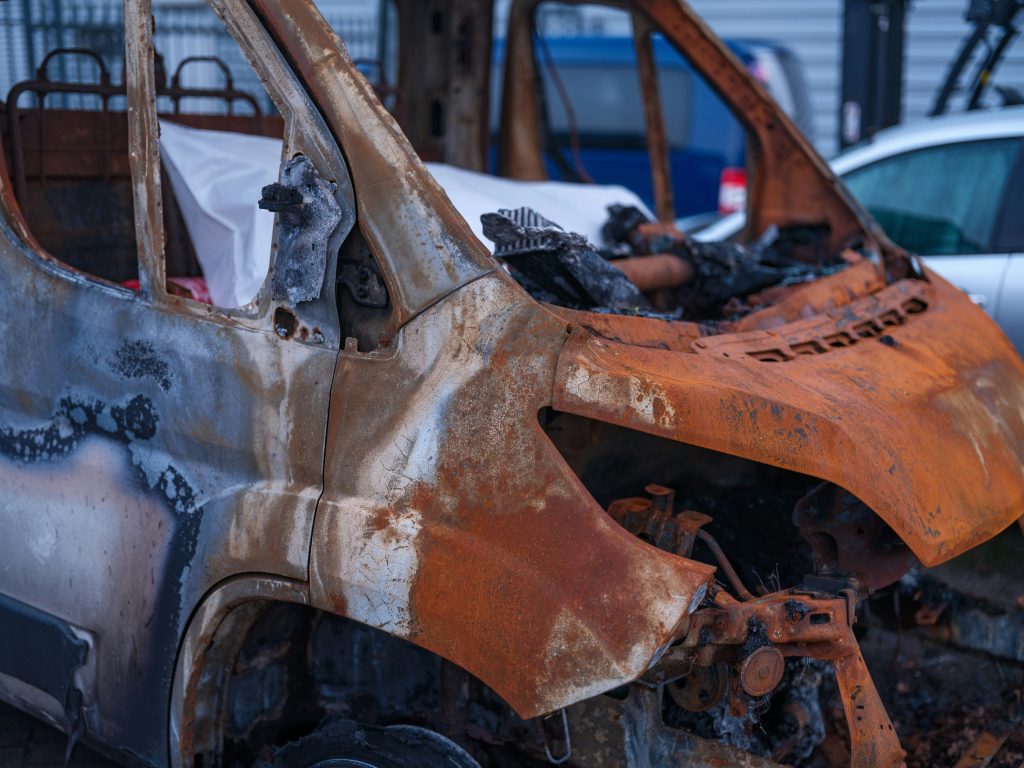Icarian Plunge: F-35’s Fiery Descent in Alaskan Skies
In a spectacle of controlled chaos, an F-35 Lightning II fighter jet succumbed to the unforgiving pull of gravity during a routine training exercise at Eielson Air Force Base in Alaska. The incident, which unfolded like a scene from a high-stakes action thriller, saw the pilot executing a daring escape just moments before the aircraft, a symbol of cutting-edge military technology, was engulfed in a dramatic, fiery implosion. This event, occurring at 12:49 p.m. local time on a seemingly ordinary Tuesday, serves as a stark reminder that even the most advanced machines are not immune to the capricious nature of fate.
The single-seat fighter, which has come to represent America’s air dominance aspirations, experienced an unforeseen malfunction as it was preparing for landing, leaving the pilot with no recourse but to engage the emergency ejection system. In a choreography of milliseconds, the pilot was catapulted away from the impending catastrophe, emerging from the ordeal with nothing more than the residue of adrenaline and the memory of a near-death experience. Meanwhile, the multi-million dollar aircraft, reduced to a mangled heap of metal, became a testament to the inherent risks that accompany the pursuit of technological advancement.
This Alaskan incident is more than just a news item; it’s a dramatic illustration of the high-wire act that is modern military aviation. Imagine a trapeze artist, performing thousands of feet above ground, where the slightest misstep can lead to disaster. This is the daily reality for pilots who command these technologically advanced marvels. The F-35, a machine lauded for its stealth, speed, and technological prowess, faced its mortality in the cold Alaskan wilderness, its once-imposing form now scattered across the landscape like a discarded toy.
## The Fragile Dance Between Man and Machine
This event brings to the fore the intricate relationship between humans and the machines they create. It showcases not just the technological marvels of modern aircraft but also the equally impressive feat of human engineering embedded in the pilot’s split-second decision-making. The incident was a vivid reminder that behind every complex piece of technology, there is a person whose split-second decisions can determine the outcome of life or death scenarios. The pilot’s ability to escape unharmed while witnessing the demise of the plane illustrates that while we strive to create machines capable of surpassing human limitations, ultimately, human resilience and ingenuity remain our most vital assets.
##### A Reminder of Risk
The fiery crash serves as a stark reminder of the risks that come with the pursuit of military power. It highlights the dangerous realities faced by those who pilot these high-tech marvels. Each flight is an act of faith and skill, a tightrope walk where error can result in tragedy. The F-35’s fiery demise, therefore, echoes beyond just a single event, bringing into focus the high-stakes gambit that is military aviation.
##### Beyond the Headlines
Beyond the immediate headlines and the sensational images of fireballs and debris, there lies a deeper narrative—one that encompasses the risks of technological dependence, the fragility of even the most advanced systems, and the unwavering courage of those who dare to challenge the boundaries of gravity. It is a narrative that should provoke reflection not just within the confines of the military but also within the broader context of technological innovation and its associated risks. While investigations continue to ascertain the cause of this incident, what is clear is that every flight, every training exercise is a dance of risk and reward. The F-35’s fiery fall in the Alaskan skies is a stark reminder that even the most sophisticated machines cannot escape the clutches of chance.
Tags: Alaska, aviation safety, Eielson Air Force Base, F-35 crash, F-35 crash Alaska, fighter jet, military aviation, military technology, pilot ejection, training accident, US Air Force
Alaska Airlines 737 MAX 9 Incident Sparks Safety Concerns Over Manufacturing Practices
In January, a harrowing incident involving an Alaska Airlines 737 MAX 9 raised significant alarm regarding the safety and manufacturing standards of commercial aircraft. During a routine flight, a door-sized fuselage panel unexpectedly blew out midair, creating a near-catastrophic situation for passengers and crew. This alarming event has prompted a thorough investigation into the manufacturing processes employed by Boeing, the aircraft’s manufacturer.
Preliminary findings indicate that the blowout was caused by a combination of two distinct manufacturing issues, which have yet to be publicly detailed as investigations continue. The consequences of this incident extend beyond the immediate danger to those aboard the flight; it has escalated scrutiny on Boeing’s quality control measures and overall commitment to maintaining high safety standards.
Officials from the National Transportation Safety Board (NTSB) have become increasingly involved, emphasizing the critical need for rigorous oversight in the aviation industry. The incident has reignited debates about the adequacy of safety protocols, particularly in light of previous concerns surrounding the Boeing 737 MAX series, which has faced its share of controversies in recent years.
As investigations unfold, aviation experts and safety analysts are calling for a comprehensive review of Boeing’s production processes. They argue that this incident could be indicative of broader systemic issues within the company’s manufacturing operations. The aviation community is on high alert, aware that the ramifications of such failures can be dire, not just for the airline involved but for the entire industry.
Furthermore, this incident has implications for regulatory bodies tasked with ensuring passenger safety. With increasing pressure on these organizations to enforce stringent safety measures, there may be a shift in how aircraft manufacturing is monitored. The potential for regulatory changes could lead to more robust guidelines that all manufacturers must adhere to, ensuring that the safety of passengers remains the paramount concern.
In response to the incident, Alaska Airlines has stated it is cooperating fully with investigators and is committed to ensuring the safety of its fleet. The airline has reassured passengers that rigorous checks are in place to prevent such occurrences in the future. However, the damage to consumer trust is already palpable, and airlines may find themselves needing to take additional measures to reassure the flying public.
As the investigation progresses, industry analysts are closely monitoring Boeing’s response and the potential repercussions for the company. The outcomes may influence future aircraft designs and manufacturing processes, setting new standards for safety in the aviation sector. It is a critical moment for Boeing, as the company seeks to regain its footing and restore confidence among airlines and passengers alike.
In conclusion, the incident involving the Alaska Airlines 737 MAX 9 serves as a stark reminder of the importance of rigorous safety standards in aviation. As investigations continue, the spotlight remains on Boeing and the broader aviation industry to ensure that such a dangerous occurrence is not repeated. The aviation world watches with bated breath, hopeful for a resolution that prioritizes the safety and well-being of all passengers.
Tags: 737 MAX 9, Alaska Airlines, aviation safety, Boeing, Manufacturing Standards
Tragic Plane Crash in Brazil Claims 61 Lives
A devastating aviation tragedy unfolded on Friday afternoon as a passenger plane operated by Voepass Airlines crashed in a residential area near São Paulo, Brazil. The aircraft, an ATR-72, was carrying 57 passengers and four crew members when it lost control and plummeted to the ground, resulting in the loss of all lives on board. Eyewitness accounts and dramatic social media footage captured the horrifying moment as the plane spiraled downwards, disappearing behind a cluster of trees before erupting into a massive plume of black smoke upon impact. The crash occurred in the gated community of Vinhedo, raising concerns about safety and regulatory oversight in densely populated areas. While the airline has yet to confirm the precise cause of the accident, investigations are ongoing, and authorities are calling for thorough scrutiny of the airline’s operational practices. The tragedy has sent shockwaves through the local community and the wider Brazilian populace, igniting discussions around air travel safety and the need for stricter regulations. As the nation mourns, many are left questioning how such a catastrophic incident could occur. The story continues to develop as more details emerge, and families of the victims seek answers.
Tags: air travel, aviation safety, Brazil, Brazil plane crash, plane crash, Voepass Airlines



